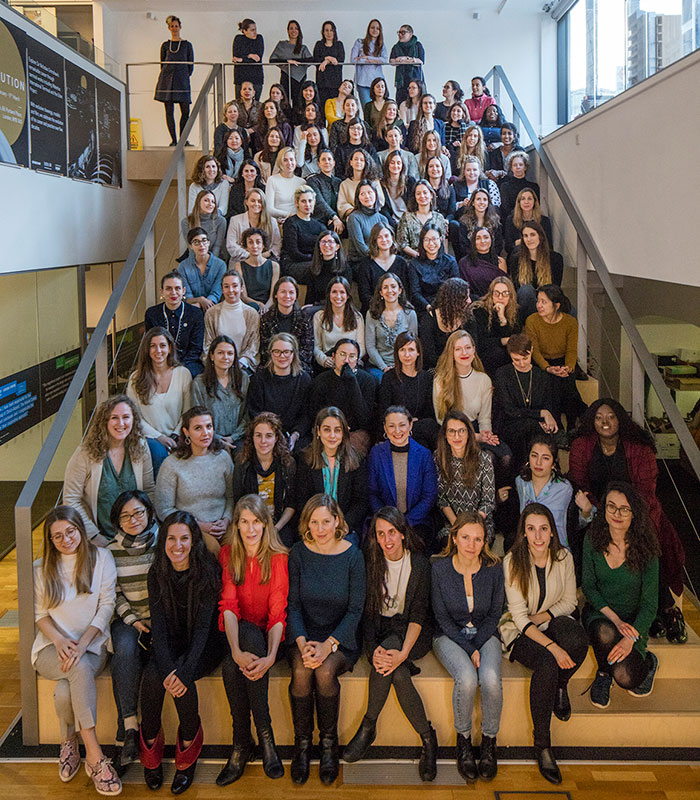Angela Dapper, Principal at Grimshaw Architects, discusses how Grimshaw Architects created an eight-part plan to improve their gender equality (and gender pay gap) in 2016.
"For a long time diversity and inclusion at Grimshaw was led through Grimshaw’s Women in Architecture group, as this had a strong presence, but we have since come to realise that there is a lot more that we need to encompass in terms of diversity. Because of this, it was important to us to create an overarching umbrella group with several contained focus groups, to offer us the insights required to address the issues affecting all our staff.
Our current Managing Partner, Kirsten Lees, has been a very strong advocate for gender equality, as well as diversity and inclusion across the office. Our practice is slightly over 50% female, and we work very hard to maintain a 50/50 balance.
In order to improve our gender equality (and gender pay gap), in 2016 Grimshaw created an eight-part plan, which was thoroughly considered to ensure that we created a measurable, evolving and constantly improving process. We have a diversity advocate in every office location around the world to oversee and manage the plan. This ensures that it doesn’t become an administration exercise – we want it to be something that everyone buys into.
Part One of the plan is the advocacy and measuring; every quarter we measure our success in several different ways — gender equality in overall number and further broken down into different levels. If all student architects are female, and all partners are male, no issues are being resolved, even though broad statistics might indicate that way.
Part Two of our plan is our recruitment policy – we make sure that a female and male are in each interview. Interestingly, a female presence at interview stage has increased the number of females we’ve hired. Within our projects we ensure that all our teams are balanced — including project architect roles — which helps take that leadership upwards.
Project opportunities constitute Part Three of our plan, as while we are now 50/50 up to Associate level it will take time to ensure this increases upwards to all letterhead. We’re making sure we create opportunities at all levels and give people the responsibility and support they need to move upwards."

"I’ve been with Grimshaw for a year, and part of the reason I moved was because of the openness of diversity within the practice. At Grimshaw, we have so many different people, with different skills and talents. We also want to be seen as diverse and inclusive externally, so we make sure that we’re putting forward diverse representation at networking and speaking events – which comprises Part Four. We had an all-female team going to MIPIM last year – the sentiment was that true balanced representation was needed, but because MIPIM is far from balanced we decided to put forward an all-female team. It worked, and we were there by design, not by statement.
Within our training and mentoring programme, we realised through monitoring that fewer women were taking up places than males – in some cases, encouragement was provided to mitigate this. As well as mentoring, advocacy is also important for all aspects of diversity – this includes finding and sharing opportunities to speak at or attend events. Part Five is about encouragement, supporting people until they grow in confidence and can stand on their own feet, becoming role models for others.
It’s an architecture-wide issue –women of a child-rearing age or in more senior positions leave the profession. At Grimshaw, we have created a benefit package for when parents return from parental leave. When I had children, it was a struggle mentally to get out of the ‘mum’ mindset and back into the ‘professional’. Once you get people into the office again, and show them support, then people realise, ‘I can actually do this’. It shows how you can support parents with flexible working, and the more we talk about it, the more it becomes acceptable to work around raising children. This is Part Six.
Part Seven is around ensuring transparency and being open to feedback, to allow us to be responsive to the changing needs of our people. Part of this is understanding why people leave, so we can learn and improve.
The final section, Part Eight, is to support career progression. Our promotion structure involves formalised protocols to support career progression, monitoring and tracking our gender pay gap and monitoring promotion procedures. We have diagrams where you can see, on every level, how many males and females we have as a percentage. As architects we respond well to visible drawn information so presenting it as an infographic is effective for communication.
A challenge of talking about women in architecture in an office like ours when we’re over 50% female, is that people start asking: ‘Is this still relevant?’. That’s why it’s good to go through the statistics to see that we’re on a journey – we haven’t fixed this issue yet. We also try to be clear that we are about being supportive of career progression for all staff, regardless of gender, so we truly create gender equality and remove barriers.
Women in architecture is a visible issue, and we have a relatively straightforward target in achieving 50/50 representation at all levels. We’re currently defining what our success should look like for wider diversity and inclusion. We want to make sure that we’re reaching out to everyone and have a way that we can engage with people to make sure that there aren’t any issues that are underrepresented or have barriers. Most of all, we want Grimshaw to feel inclusive for everyone. We want you to bring your true self to work."
Find out what other RIBA Chartered Practices are doing to address the gender pay gap.









